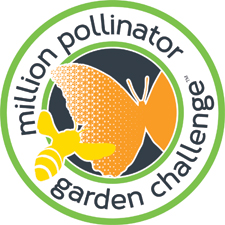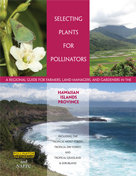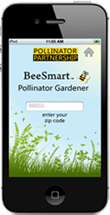Join the Million Pollinator Garden Challenge
What is the Million Pollinator Garden Challenge (MPGC)?
Million Pollinator Garden Challenge: A nationwide call to action to preserve and create gardens and landscapes that help revive the health of bees, butterflies, birds, bats and other pollinators across America. We will move millions of individuals, kids and families outdoors and make a connection between pollinators and the healthy food people eat.
 The Million Pollinator Garden Challenge is a project of The National Pollinator Garden Network (NPGN) an unprecedented collaboration of national, regional, conservation and gardening groups. Its eight founding private nonprofit members were convened in fall 2014 to propose public/private sector efforts to help restore critical pollinator populations in support of the President’s Executive Strategy to “Promote the Health of Honey Bees and Other Pollinators.”
The Million Pollinator Garden Challenge is a project of The National Pollinator Garden Network (NPGN) an unprecedented collaboration of national, regional, conservation and gardening groups. Its eight founding private nonprofit members were convened in fall 2014 to propose public/private sector efforts to help restore critical pollinator populations in support of the President’s Executive Strategy to “Promote the Health of Honey Bees and Other Pollinators.”
What you can do? Tips for Creating a Pollinator Friendly Garden Habitat
By planting a pollinator-friendly garden you are making a difference for honey bees, bumble bees, other bees and pollinators that bring us 1 in every 3 bites of food.
Establishing habitat can be challenging but there are certain things you can do to make it easier and more successful. You are probably aware of many of the points listed below; use what is helpful to your site and disregard what is not.
Site Selection
- Choose a sunny location.
- Pick a site that has water access; most plantings usually need water for at least the first few weeks while they establish.
- Start with a manageable size for YOU to plant and maintain – a window box is enough if that is what works for you.
- Look for sites that are protected from strong wind.
- Provide nearby ground nesting sites with bare ground or debris (don’t be too tidy!) and wood nesting sites with wood blocks.
- Provide a source of water.
Plant Selection - Plants vs. Seeds
- Seeds will take longer to provide habitat, but they can cover more ground and cost less.
- Select native plants whenever possible (the FREE ecoregional planting guides at www.pollinator.org are really helpful for all!)
- The plants you select must provide nectar for carbohydrate and pollen for protein to the pollinators.
- Different floral shapes and colors will attract different pollinators. The Pollinator Partnership’s Ecoregional Guides will help identify pollinator needs.
- Monarch butterflies require regionally specific milkweeds on which they will lay their eggs, and also nectar supplying plants to fuel their flights.
- Though native plants are most helpful to local ecosystems and pollinators; here is a list of plants that do pretty well everywhere and are widely available:
- Lavandula spp. (Lavender)
Rosemarinus officinalis (Rosemary)
Salvia spp. (Sage)
Echinacea spp. (Coneflower)
Helianthus spp. (Sunflower)
Cercis spp. (Redbud)
Nepeta spp. (Catnip)
Penstemon spp. (Penstemon)
Stachys spp. (Lamb’s ears)
Verbena spp. (Verbena)
Phacelia spp. (Bells or Phacelia)
Aster spp. (Aster)
Rudbeckia spp. (Black-eyed Susan)
Origanum spp. (Oregano)
Achilliea millefolium (Yarrow)
Planting/Seeding Instructions:
- Plant like plants together – pollinators like large targets to find their source of food.
- Plan for continuous bloom throughout the growing season so that a good food source is always in bloom.
- Once you get your seed, store it in a cool dry place until you are ready to seed. Never store seed in a car, plastic bag or outside.
- If you are uncertain, check the pH of your soil. For forge seed germination and establishment, the pH should be between 5.0 and 7.0. An inexpensive pH meter can be used to conduct this test. Remove all weeds and other debris from the pollinator buffer site.
- Remove all grassy areas before seeding.
- Evenly scatter the seed throughout.
- If deer are a problem, install a deer fence.
- Cover the newly scatter seed with no more than 1/4” of soil.
- Water the newly seeded pollinator buffer weekly for 4-6 weeks post-seeding (if it is extremely hot and dry, water more frequently).
Maintenance and Beyond
- Be sure to have an Integrated Pest Management (IPM) program in order to eliminate the impact of pesticides on pollinators. Access to clean forage is critical to pollinator health.
- Register your pollinator habitat – no matter what the size – on the Pollinator Partnership’s SHARE site (Simply Have Areas Reserved for the Environment). You can create an account there and upload photos or videos of your pollinator garden. You will locate your pollinator garden on a Google map that can be visited and updated again and again and connects you to all the “pollinator people” across the United States who are “sharing” a part of their neighborhood for pollinators.



